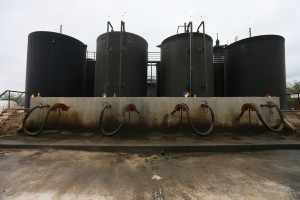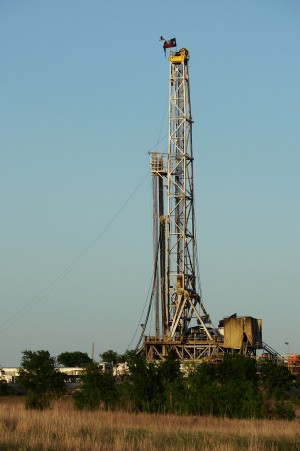How Wasted Gas From Drilling Could Save Millions of Gallons of Texas Water
Millions of gallons of water from hydraulic fracturing, or “fracking,” could be treated and reused without extra energy costs using gas that is typically burned off at drilling sites, according to a new study by a team of scientists at the University of Texas at Austin.
Enough natural gas is burnt on site to fuel energy-intensive treatment for highly-contaminated water, making for a handy ‘Two Birds, One Stone’ opportunity, the study by UT’s Webber Energy Group finds.
“You’ve got two environmental problems: extra energy that is flared and a lot of dirty water. You put them together, and you solve two problems at once,” says Michael Webber, Deputy Director of UT’s Energy Institute and co-author of the study.
Reusing fracking wastewater treated by gas that would usually be flared instead could supply the equivalent of three to nine percent of the state’s yearly urban water demand, according to Kelly Sanders, a co-author of the study. As Texas drought persists and water supplies are strained, the revelation that unused natural gas could fuel treatment may compel drillers to pay more to reuse their water. But the technology’s not quite there yet.
In Texas, about one percent of natural gas released from fracturing fuel-rich shale is discarded in flares according to state regulators, but it’s still plenty of fuel that could be put to good use. In 2012, for instance, the amount of natural gas flared in Texas could have met the energy needs of about 400,000 Texans, according to Sanders.
Hydraulic fracturing, or fracking, is a drilling process where millions of gallons of high-pressured water is injected thousands of feet below ground to shatter rock that holds oil and gas in many small pores like Swiss cheese. Combined with horizontal drilling, fracking has led to a massive increase in domestic oil and gas production, now at a 25-year high.
“The problem for Texas is that it’s incredibly water scarce and in some places there is very little water for the oil and gas industries,” Sanders says. “So there’s an incentive to create a better way to manage water because they simply don’t have enough of it.” In California, lawmakers are debating instating a fracking moratorium as the drought grows more severe.
Each new well drilled in Texas generates the equivalent of three to ten Olympic-sized swimming polls full of toxic wastewater. Some of it water that was put down the well for fracking, the rest of it water that was already in the formation, known as “produced water.” This drilling wastewater is contaminated with radioactive materials, salts, arsenic and a host of other chemicals, making treatment very costly and energy-intensive: treating wastewater from a single well can require as much energy as 22 American households use in a year.
In 2012, about 15,000 new wells were drilled in Texas, Sanders said. Drillers generally discard wastewater in Texas by injecting it into deep disposal wells. That practice has been criticized for causing earthquakes and potentially contaminating future supplies of water that could be treated through desalination.
“Generally speaking, injecting the nasty water out of the cycle down below ground is considered a safer, more environmentally-sound way to treat it rather than spending so much energy to treat it then still having a brine stream to deal with afterwards,” says Webber.

Photo by Jennifer Whitney/Texas Tribune
Each day, dozens of trucks hook up to the Gulf Coast-run fracking fluid disposal well site near Gonzales, TX. A new bill would make it easier to transfer the wastewater by pipeline instead of by truck, potentially reducing roadway damage.
Though the energy exists to treat water onsite, there isn’t available technology to make it efficient.
“The next question is, how do you actually do it? We did not do that research. The next step is to figure out how to actually capture the gas,” Webber says.
Treating water on-site would require modular facilities that could be moved between tens of thousands of fracking wells in Texas. Current treatment technologies basically entail boiling water and collecting vapor or forcing it at high pressure through a fine membrane filter.
“The jury’s still out on the best water treatment technology. There’s been a lot of work in academics and industry to develop technologies that are viable and efficient for treating this produced water, but it’s been a challenge,” says Sanders.

